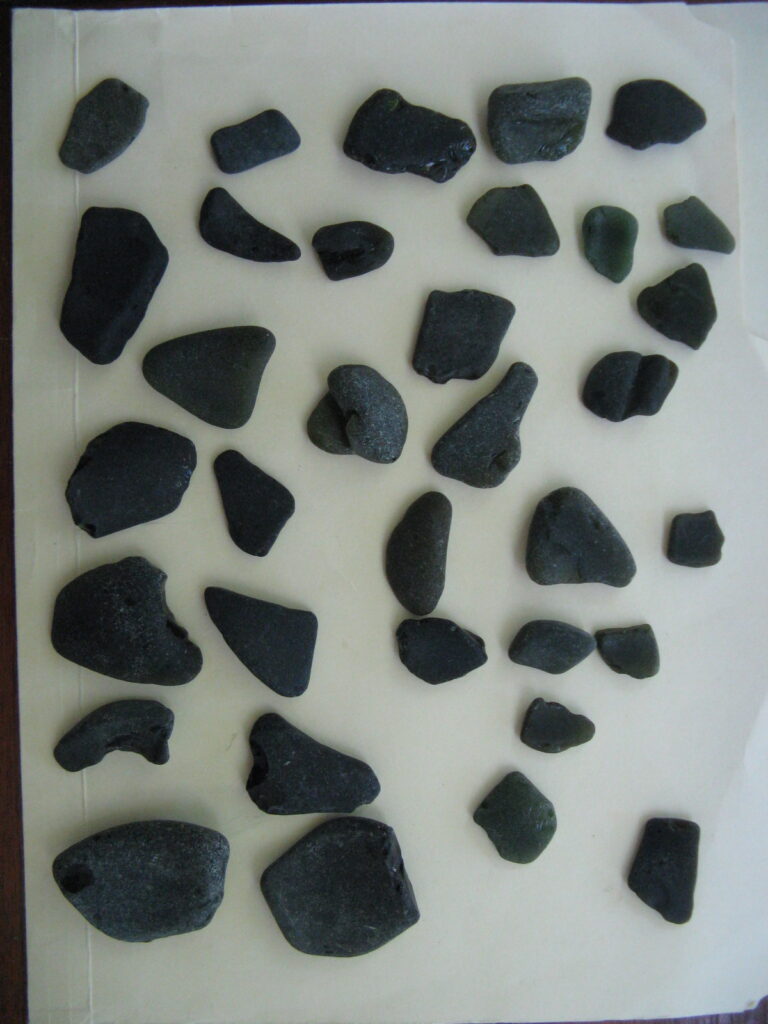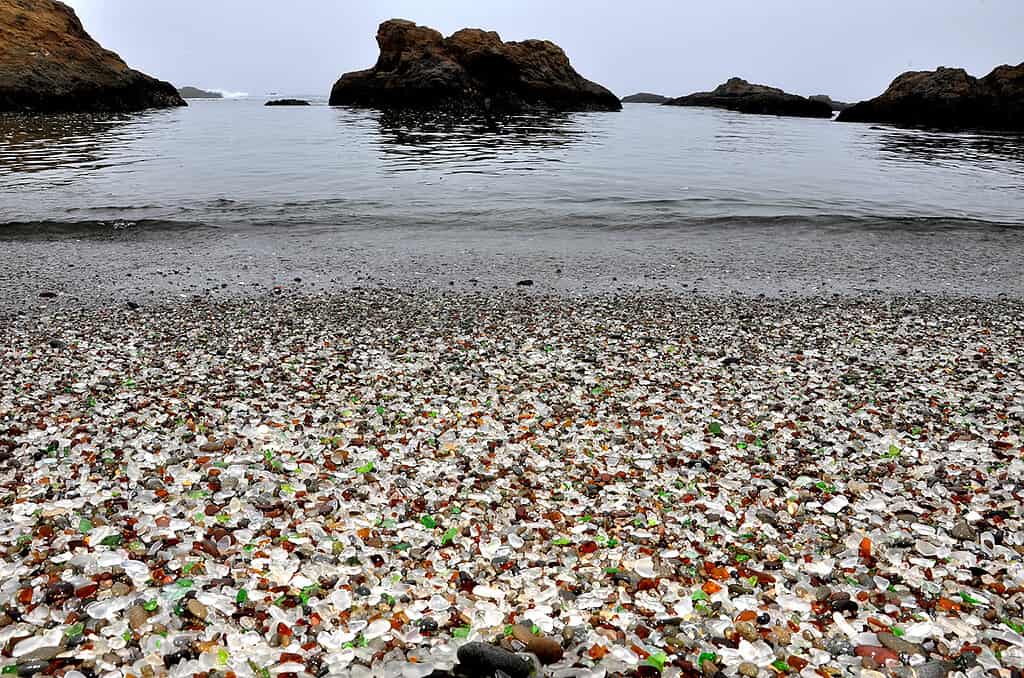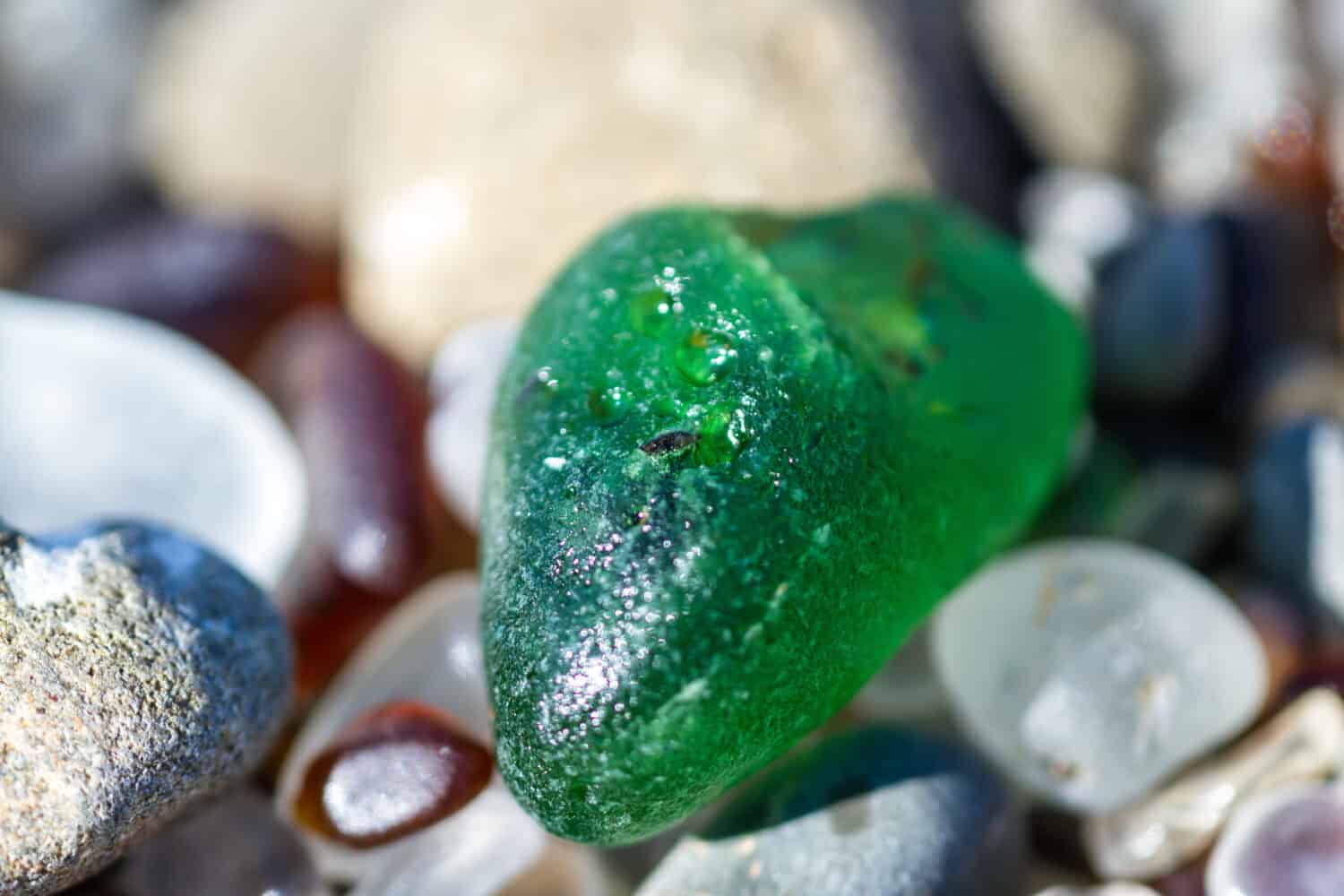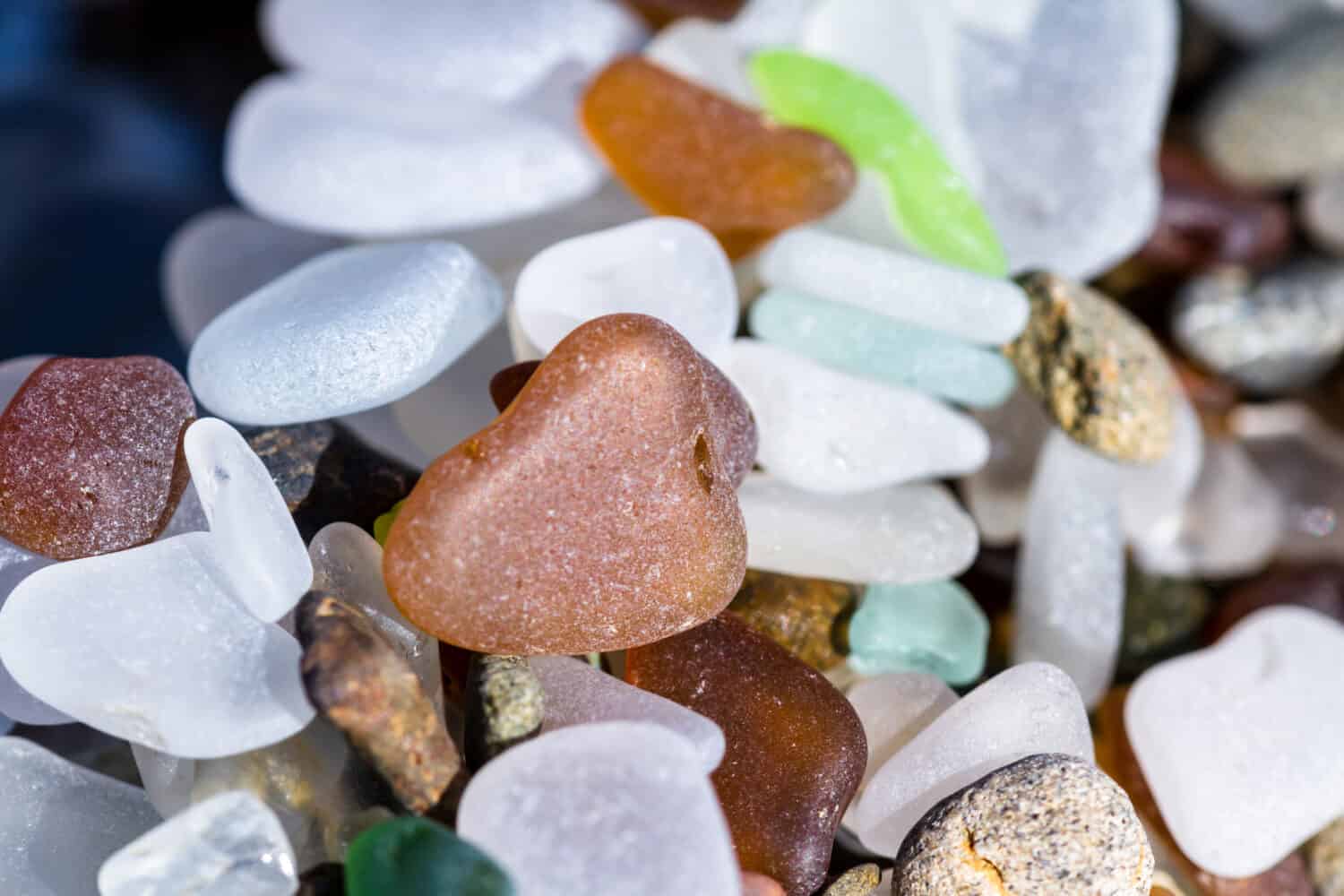The sandy coastal shorelines are home to many precious gems. Among the most valuable items you’ll find when combing through the endless grains of seashore sand are various sea glass colors.
The rarest sea glass hues are more valuable than the typical colors on many local beach shores. Rare sea glass also makes unique art, ornaments, and jewelry and fetches a reasonable price in the market.
If you’re gearing up for your next beachcombing experience, look for these twelve rare sea glass color variants. They provide the highest return for your time, effort, and resources and can be easily found if you know exactly where to look and what to look for.
The diversity of sea glass colors reflects the wide range of glassware that was once discarded and transformed into captivating jewels of the sea, making beachcombing a delight for collectors and admirers of these beautiful coastal gems.

Ultra Rare Sea Glass
The ultra-rare sea glass colors are the least likely to appear on seashores or as ornaments and jewelry in the market. Their presence is limited to regions with specific weathering conditions, such as high-intensity sea waves and currents.
The different types of colors under the ultra rare category are:
1. Orange

Orange sea glass is the rarest sea glass color as it comes from old glassware items, such as bowls, bottles, vases, and other decorative glass items with selenium or gold additives.
©Markgraf/Shutterstock.com
Orange sea glass is the rarest sea glass color. It comes from old glassware items, such as bowls, bottles, vases, and other decorative glass items with selenium or gold additives. Like many rare sea glasses, orange sea glass undergoes decades of weathering to transform into the final well-polished, smooth, and frosted end product.
While the orange color of this sea glass is unique and readily identifiable on the surface, few beachcombers manage to find it.
The rarity of this color stems from the limited glass items made in the orange color. Historically, only select companies, like the Virginia-based New Martinsville Glass Company, produced mass orange glass items. That means only a limited amount of orange glass waste finds its way into water bodies.
The presence of orange sea glass is also limited to select coastal areas, especially regions with glass-producing companies or factories.
2. Turquoise

Variations of the turquoise sea glass can range from light to delicate, deep, and intense blue.
©Dane Gillett/Shutterstock.com
Turquoise is the second-rarest sea glass color. This blue-colored sea glass resembles the ocean’s color and comes from decorative glasses, medicine bottles, dishes, vases, and stained windows.
Since these items aren’t mass-produced, the presence of turquoise sea glass on the shorelines could be higher. The weathering process of turquoise sea glass is also location-specific, meaning only select sea conditions can produce the genuine turquoise sea glass color.
Other factors that can influence the integrity of a turquoise sea glass color are its copper content and exposure to natural sea elements. The more copper in glass material and the longer it’s exposed to natural sea elements, the deeper the turquoise shade and vice versa.
Variations of the turquoise can range from light to delicate, deep, and intense blue. The chances of finding these shades of turquoise depend on a region’s glass production activity and the presence of coastal shorelines.
3. Yellow

The most yellow sea glass-predominant regions are close to breweries and glassware manufacturing companies.
©Vera Larina/Shutterstock.com
Yellow sea glass is the third-rarest sea glass color. According to research, about 1 in 3,500 sea glass is likely yellow beach glass. This glass color’s rarity stems from the glass materials’ longevity.
The primary materials used to make yellow glass are vintage bottles, jars, and fine dinnerware. Most people rarely throw away these items, so finding yellow glass waste dumped in oceans can be difficult.
If you find yellow sea glass on a shoreline, the yellow shade might be the original version or a variation depending on its origin. The yellow tint is usually warmer and more glistering for glasses with selenium or uranium additives. In contrast, variations of sulfur and iron have a soft and mellow yellow shade under ultraviolet rays.
The most yellow sea glass-predominant regions are close to breweries and glassware manufacturing companies. However, locating a yellow sea glass also depends on the historical context of a region in terms of glass production activity.
4. Red

The limited presence of red sea glass in water bodies is mainly due to the limited supply of red glassware today.
©Nature’s Charm/Shutterstock.com
Finding a well-tumbled, frosted piece of red sea glass is rare, even on glass-predominant sea shorelines. The limited presence of red sea glass in water bodies is mainly due to the limited supply of red glassware today.
In the past, the significant sources of red glassware were red dinnerware made in the 18th and 19th centuries, all of which have already halted production. The remaining red glass sources are art glasses, old wine, beer bottles, and old ship and car tail lights.
These items rarely deteriorate due to the increased strength of red glassware materials. Generally, red glass items are thicker and stronger than most other colors, which makes them more durable and less likely to be disposed of in the sea.
When scouring the shores for red sea glass, you’ll likely come across various shades of red glass. Depending on the glass’s chemical composition and weathering period, these can range from shades of lighter pink and amber to crimson.
Regardless of the red hue you find, the red glass color is guaranteed to add sparkle and shine to your collection and command a reasonable market price.
Extremely Rare Sea Glass
The second group of sea glass colors is the scarce type. While the presence of this sea glass is significantly higher than the ultra-rare colors, finding one remains challenging due to their limited numbers. They include:
1. Black

A collection of extremely rare black sea glass.
©Tomcat Ranger / CC BY-SA 4.0 – License
Black sea glass is one of the oldest beach glass colors. Its dark appearance and scarcity make it a mysterious and highly coveted sea glass color by beachcombers worldwide.
The origin of the black sea glass dates back to the 18th century when most liquor and beer bottles had dark color. Some historical glass artworks and shipwrecks have dark hues like olive green and amber.
The shade of black in sea glass varies depending on the iron oxide content. The more iron oxide in glass, the thicker it appears and the darker its shade after weathering.
You can determine the shade of a black sea glass by observing it under the sun’s rays. Some collectors also recommend holding a dark sea glass over artificial light to see if it’s an original black hue or a variation. The common variations of the black sea glass include blue-black and dark green.
2. Gray

Sea glass hunters could chance upon rare pieces of gray sea glass at Glass Beach, Fort Bragg.
©Ggerdel / CC BY-SA 4.0 – License
Gray is the sixth-rarest sea glass color deposited by sea currents and waves on seashores. Unlike the other rare glass colors, gray sea glass has multiple sources – some dating back to the 1900s while others are active today.
The historical sources of gray sea glass include crystal glass tableware that contained lead oxide, which promoted their gray sparkle. On the other hand, the current sources of gray sea glass include television sets and vehicle windows with selenium and iron oxide additives.
Glasses with lead oxide have a lighter gray hue, while those with selenium and iron take a darker gray appearance. The darkest shades of gray glass are the most coveted and have the highest value in the market.
3. Pink

Pink sea glass sits among this cluster of sea glass four at Fort Bragg, around 40 years old.
©Anna39/iStock via Getty Images
Pink is an extremely rare color in the sea glass rarity chart. The origins of this color are low-end materials made during the Great Depression, like pink tableware, plates, and vases.
Some glass perfume bottles and medicine containers also transform into pink sea glass variations after years of the natural weathering process. It’s rare to find pink sea glass on shorelines because of the limited production of pink glassware today.
The only shade of pink sea glass you’ll likely find is the lighter pink variation. This type contains selenium, which gives off a light shade of pink under UV rays. The pale pink tones are less coveted than those with a richer shade of pink.
Also, the location of a pink sea glass can range from one place to another. The best way to find a rich pink shade is to scour as many shorelines as possible, particularly those near pink glassware manufacturing companies.
Rare Sea Glass
The last group of rare sea glass colors is present in most coastal shorelines today. These colors have a wider variety of sources and origins than all other rare sea glass types. The different types of rare glass include:
1. Green

Green sea glass has more hues than the other glass colors.
©Nature’s Charm/Shutterstock.com
Green sea glass tops the list of the less rare sea glass hues across different water bodies. It comes from old beer and soda bottles and other green decorative materials discarded as waste into the sea. Green sea glass has the most shade variations compared to other shades in this category.
The different hues of green glass are:
- Bright green: Light green sea glass is the majority of the green glass family. The primary sources of this color are glass beer and soda bottles, like the Sprite bottle. Color variations in this category can range from light green to yellowish-green, depending on the thickness of the glass.
- Medium or jade green: The jade or olive green sea glass has a deeper green hue than the bright green sea glass. Since the 1950s, this glass has mainly been come from used in jars, bottles, bitters, and decorative glassware deposited in the sea.
- Dark or emerald green: Glass materials with decades of weathering and high mineral presence develop a dark rich green tone. This shade is darker than olive green and is the most coveted. The main origins of the dark green hue are liquor bottles such as gin bottles and some wine bottles too.
The most tumbled, frosted, and smoothened green glass shades make beautiful jewelry and ornaments. These precious collectibles also fit into all existing glass colors and are often confused with small green rocks on sea shorelines.
2. Cobalt Blue

Although rare and highly sought after, cobalt blue sea glass is among the most common glass colors deposited on sea shorelines.
©Brewster’s Fine Bees/Shutterstock.com
Although rare and highly sought after, cobalt blue sea glass is among the most common glass colors deposited on sea shorelines. The primary sources of cobalt-blue glass are ink, poison, seltzer medication bottles, plus other cobalt-blue decorative glassware.
The rarest and most coveted shade of copper blue is the genuine cobalt blue color. It has a high level of cobalt oxide, which gives it a richer blue pigment and a more polished and smooth appearance than other shades.
You can test the integrity of a cobalt blue shade by holding it in direct sunlight. The more transparent the hue is, the less valuable it is, whereas the more concentrated the blue tint is, the purer the sea glass. Cobalt blue sea glass is also closely related to the cornflower sea glass color and can be mistaken for it.
3. Purple

Purple sea glass is dwindling on beaches because of the limited production of purple glass materials.
©A.Greeg/iStock via Getty Images
Purple sea glass is a scarce sea glass color with allure and mystery. It’s derived from decorative glassware and old glass bottles used to store medicine and other liquids in the 1950s.
The purple shade of sea glass depends on the materials used to make it and its decomposition period. Shades with manganese make lighter purple tones, while the selenium-based glasses that undergo the entire weathering process have highly-coveted lavender color and intense purple shade.
Currently, the number of purple sea glass on sea shores is dwindling at a high rate due to the limited production of purple glass materials. Many purple glass materials in seas are also undergoing a partial weathering process, which reduces the number of valuable purple glass hues available on shores.
4. Opaque (White Glass)

White sea glass originated from glass bottles used to store manufactured milk but later transitioned to plates, vases, and hand cream packaging materials.
©Nature’s Charm/Shutterstock.com
The white opaque sea glass is a rare color with an elegant, milky appearance. It originated from glass bottles used to store manufactured milk but later transitioned to plates, vases, and hand cream packaging materials.
The shade of white on a sea glass can vary depending on the opaqueness of the glass. Some have a smooth, well-frosted, and non-translucent appearance, while others are translucent and can allow small UV rays to pass through.
You can combine white glass colors with many colors to make mosaic jewelry and crafts with a contrasting appearance. Generally, the vintage appeal of white sea glass makes it the most versatile and effective of all rare sea glass colors in evoking different emotions and intrigue in people.
5. Amber

The amber or golden sea glass has a rich brown color that comes from brown glassware, such as brown whiskey, beer, medical, and cleaning bottles.
©AllaLear/Shutterstock.com
The amber or golden sea glass has a rich brown color that resembles natural beauty. This glass color comes from brown glassware, such as brown whiskey, beer, medical, and cleaning bottles.
The main components inside amber glasses are carbon and sulfur compounds.
These compounds are responsible for the shade of brown color an amber sea glass develops after the weathering process. The more carbon and sulfur compounds in glass material, the deeper the vintage amber color and vice versa.
Also, the weathering process, impurity presence, and exposure to sea elements can influence the color variation of sea glass. The deepest amber colors have the most value and can form a variety of stunning jewelry and art designs.
The butternut is the darkest and rarest version of the amber sea glass color. It has a deep, rich golden color, whereas the lighter version takes yellow and reddish tones.
Find the Best Sea Glass Colors Around Local Sea Shores In Your Region
Sea glass has many different colors. Each type looks different from the other and has different origins and unique characteristics. It would help if you started looking for the less rare sea glass colors since they’re easier to find even on local and regional beach shorelines. Once you’ve exhausted all the rare colors in your local area, you can expand your search for the extremely rare sea glass to other regions.
Remember, the rarest sea glass colors are in regions with plenty of waterbodies and glass manufacturing activity. Take your time combing through the sands to increase your chance of finding a rare sea glass color. When searching, pay most attention to the sea glass colors, like orange, red, black, and pink. These scarce colors are often mistaken for rocks, pebbles, or other glass materials on seashores.
The fascination of sea glass lies in its capacity to capture our imagination and serve as a constant reminder of the water’s ephemeral nature and the beauty that can be found in even the most commonplace things. Whether it is discovered in a single color or a rainbow of hues, sea glass never ceases to amaze and motivate people who value the undiscovered wonders of the seaside.
Summary of the Top 12 Rarest Sea Glass Colors
| Sea Glass Color | Rarity | |
|---|---|---|
| 1 | Orange | Ultra rare |
| 2 | Turquoise | Ultra rare |
| 3 | Yellow | Ultra rare |
| 4 | Red | Ultra rare |
| 5 | Black | Extremely rare |
| 6 | Gray | Extremely rare |
| 7 | Pink | Extremely rare |
| 8 | Green | Rare |
| 9 | Cobalt Blue | Rare |
| 10 | Purple | Rare |
| 11 | Opaque (White) | Rare |
| 12 | Amber | Rare |
The photo featured at the top of this post is © Nature's Charm/Shutterstock.com
Thank you for reading! Have some feedback for us? Contact the AZ Animals editorial team.






